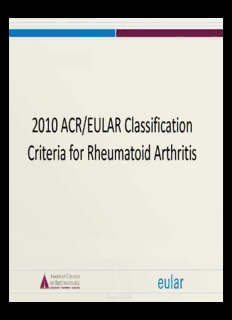
2010 ACR/EULAR Classification Criteria for Rheumatoid Arthritis PDF
Preview 2010 ACR/EULAR Classification Criteria for Rheumatoid Arthritis
2010 ACR/EULAR Classification Criteria for Rheumatoid Arthritis Published in the September 2010 A&R ARD Issues of and Phases of the Project Phase 1 Phase 2 Data analysis Consensus process Predictors of MTX Determinants of high initiation probability of RA Phase 3 Integration of 1 and 2 Increase feasibility Final Criteria Phase 1 Data Driven Approach Phase 1: Patients and Methods • Patients – EARLY ARTHRITIS COHORTS – 3115 patients from 9 cohorts – Inflammatory arthritis (no other definite diagnosis) of <3 years – No previous DMARD/MTX treatment • Methods – PREDICTORS OF MTX TREATMENT – Step 1: Univariate regression analysis of all possible variables – Step 2: Principal component analysis: identify themes – Step 3: Multivariate regression analysis with all relevant themes Phase 1: Three Analytic Steps Identify significant variables at baseline Univariate Regression Analysis Gold standard: MTX treatment at one year STEP 1 Identify sets of Principal Component Analysis variables representing the same “theme” STEP 2 Identify independent effects of variables and Multivariate regression Analysis their relative contribution (“weight”) STEP 3 STEPS 1 and 2: Predictors of MTX initiation Loadings on Factors 1-6 Factor No (Eigenvalue) 1 (5.33) 2 (1.91) 3 (1.62) 4 (1.15) 5 (0.99) 6 (0.94) Anit-Citrullinated peptide AB (0,1,2) .104 .064 .035 .079 .094 .878 Rheumatoid factor (0,1,2) .105 .013 .064 .053 .117 .878 CRP (0,1,2) -.004 .101 -.049 .847 .004 .055 ESR (tertiles) .012 .026 -.042 .847 -.042 .121 HAQ (tertiles) .103 .180 .343 .555 .062 -.074 SJC (1,2-6,7-28) .612 .356 .198 .075 .526 .125 MCP swelling (yes/no) .839 .103 .282 .017 .149 .158 PIP swelling (yes/no) .287 .138 .082 -.003 .852 .176 Wrist swelling (yes/no) .165 .865 .140 .119 .055 .102 MTP swelling (yes/no) .055 .047 .024 .009 .022 .127 Tender Joint count (1, 2-6, 7-28) .268 .204 .767 .058 .384 .047 MCP tenderness (yes/no) .509 .014 .723 -.003 .108 .094 PIP tenderness (yes/no) .103 .045 .550 -.048 .710 .098 Wrist tenderness (yes/no) .001 .658 .599 .036 .001 .048 Symmetrical MCP swelling .826 .205 .095 .039 .163 .062 Symmetrical wrist swelling .229 .785 -.024 .133 .194 -.037 Loadings: 0 – 0.199 0.2 – 0.399 0.4 – 0.599 0.6 – 0.799 0.8 – 1 STEP 2: Relevant Themes to Predict MTX Treatment Factor Loading variables Theme Represented by 1 SJC, MCP , MCP “MCP MCP swelling SW SW-Sym involvement” 2 Wrist , Wrist , “Wrist Wrist swelling SW TD Wrist involvement” SW-Sym 3 TJC, MCP , PIP “Hand/finger PIP or MCP or wrist TD TD tenderness” tenderness 4 CRP, ESR “Acute phase Abnormal CRP or response” abnormal ESR 5 PIP , PIP “PIP PIP swelling SW TD involvement” 6 ACPA pos., RF pos. “Serology” Pos. ACPA or pos. RF Phase 1: Results Variable Comparison P OR (95% CI) Weight Swollen MCP Pres vs. abs 0.003 1.46 (1.14 to 1.88) 1.5 Swollen PIP Pres vs. abs 0.001 1.51 (1.19 to 1.91) 1.5 Swollen wrist Pres vs. abs <0.001 1.61 (1.28 to 2.02) 1.5 Hand tenderness Pres vs. abs <0.001 1.80 (1.33 to 2.44) 2 Mod. vs. normal 0.172 1.24 (0.91 to 1.70) 1 Acute phase High vs. normal 0.001 1.68 (1.23 to 2.28) 2 Mod. vs. normal <0.001 2.22 (1.81 to 3.28) 2 Serology High vs. normal <0.001 3.85 (2.96 to 5.00) 4 Phase 1: Conclusion • Swelling of small joint regions (PIP, MCP, wrist) has independent effect • Tenderness might be also be considered as “joint involvement” • Symmetrical involvement does not seem to have a significant incremental effect over unilateral involvement • Abnormal acute phase response has a considerable effect • Serology has a considerable effect, and shows a “dose- response” relationship of titres
Description: